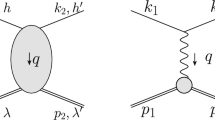Summary
We investigate the strong decrease of the isovector nucleon form factors in the spacelike region—which empirically can be adequately described by the dipole fit—through a dispersion-theoretical description of the ππ →N \(\bar {\mathcal{N}}\) scattering amplitude in the ρ-resonance region. To that extent we consider on the right-hand cut besides the elastic contribution the influence of the uncorrelated 2π exchange and on the left-hand cut besides the nucleon pole and the isobar exchange the contributions of box diagrams in the sense of a strip approximation in the Mandelstam plane. We find that the electric Sachs form factor can be described completely through the nucleon pole and the uncorrelated 2π exchange, whereas for the magnetic form factor one needs in the region below the ρ resonance a contribution which is about 2 1/2 times the magnitude of the nucleon pole. The decrease in the spacelike region is very sensitive to variations of the ππ scattering phase shift above the ρ-resonance.
Riassunto
Si esamina il forte decremento dei fattori di forma isovettoriali del nucleone nella reazione spaziale — che possono essere adeguatamente descritti empiricamente dall’approssimazione dipolare — per mezzo di una descrizione in teoria delle dispersioni dell’ampiezza dello scattering ππ→N \(\bar {\mathcal{N}}\) nella regione della risonanza ρ. A questo scopo si prendono in considerazione sul taglio a destra, oltre al contributo elastico, l’influenza dello scambio di 2π e sul taglio a sinistra, oltre al polo del nucleone ed allo scambio di isobaro, il contributo dei diagrammi a scatola nel senso di un’approssimazione a strisce nel piano di Mandelstam. Si trova che il fattore diforma di Sachs elettrico può essere descritto completamente per mezzo del polo del nucleone e lo scambio di 2π non correlato, mentre per il fattore di forma magnetico è necessario, nella regione sotto la risonanza ρ, un contributo che è circa 2 volte e mezzo la grandezza del polo del nucleone. Il decremento nella regione spaziale è molto sensibile alle variazioni dello spostamento di fase dello scattering ππ sopra la risonanza ρ.
Реэюме
Мы исследуем сильное убывание иэовекторных нуклонных форм-факторов в пространственно-под обной области, которое змпирически может быть адекватно описано с помошью дипольной подгонки, посредством дисперсионного теоретического описания амплитуды рассеяния ππ →N \(\bar {\mathcal{N}}\)в области р-реэонанса. Для зтого мы рассматриваем на правостороннем раэреэе кроме упругого вклада влияние некоррелированного 2π-обмена, а на левостороннем раэреэе кроме нуклон-ного полюса вклады от обмена иэобарами для диаграмм типа яшика в смысле стрип-приближения в плоскости Манделстама. Мы находим, что злектрический форм-фактор Сакса может быть полностью описан череэ нуклонный полюс и некоррелированный 2π-обмен, тогда как для магнитного форм-фактора в области ниже р-реэонанса необходим вклад, который составляет 21/2 величины нуклонного полюса. Рассмотренное убывание в пространственно-под обной области очень сушественно к иэменениям фаэового сдвига ππ рассеяния выще р-реэонанса.
Similar content being viewed by others
References
S. Furuichi, H. Kanada andK. Watanabe:Progr. Theor. Phys.,38, 636 (1967).
D. H. Coward, H. DeStaebler, R. A. Early, J. Litt, A. Minten, L. W. Mo, W. K. H. Panofsky, R. E. Taylor, M. Breidenbach, J. I. Friedman, H. W. Kendall, P. N. Kirk, B. C. Barish, J. Mar andJ. Pine:Phys. Rev. Lett.,20, 292 (1968).
W. Albercht, H. J. Behrend, H. Dorner, W. Flauger andH. Hultschig:Phys. Rev. Lett.,18, 1014 (1967).
M. Goitein, J. R. Dunning, jr. andR. Wilson:Phys. Rev. Lett.,18, 1018 (1967).
C. Berger, E. Gersing, G. Knop, B. Langenbeck, K. Rith andF. Schumacher:Phys. Lett.,28 B, 276 (1968).
J. E. Augustin, J. C. Bizot, J. Boun, J. Haissinski, D. Lalanne, P. Marin, H. Nguyen Ngoc, J. Perez-y-Jorba, F. Rumpf, E. Silva andS. Tavernier:Phys. Lett.,28 B, 508 (1969).
G. Höhler, R. Strauss andH. Wunder: preprint July 1968.
S. D. Drell andF. Zachariasen:Electromagnetic Structure of Nucleons (Oxford, 1961).
A. Minten: CERN 69-22, August.
G. F. Chew andS. Frautschi:Phys. Rev.,123, 1478 (1961).
M. Jacob andG. C. Wick:Ann. of Phys.,7, 404 (1959).
J. M. Moffat: preprint Toronto July 1968.
Author information
Authors and Affiliations
Additional information
Work supported in part by the German Bundesministerium für Bildung und Wissenschaft.
Rights and permissions
About this article
Cite this article
Brall, U., Rodenberg, R. Influence of higher-order cut contributions and of the asymptotic behaviour of the ππ scattering phase shift on the decreasing properties of the isovector nucleon form factors. Nuov Cim A 8, 381–415 (1972). https://doi.org/10.1007/BF02732657
Received:
Published:
Issue Date:
DOI: https://doi.org/10.1007/BF02732657




